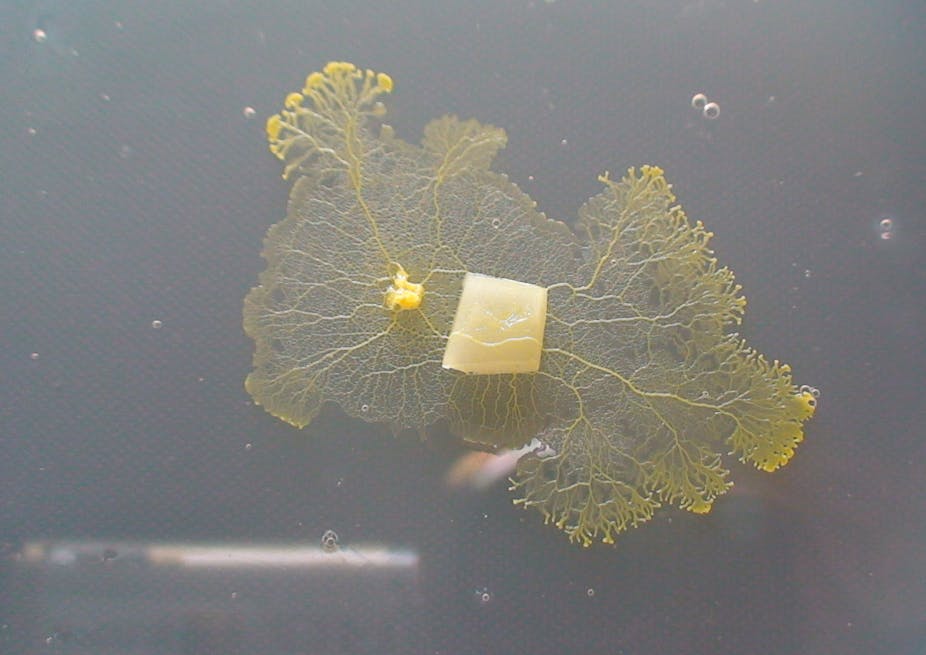We humans use our large brains to make and store maps of our environment; maps we then use everyday for getting around and for recalling where we’ve been. But we are nothing special – many other animals are capable of using spatial memory to make life easier.
And while many animals have this ability, spatial memory has so far only been described in animals with brains to store the memories in. Until now.
My colleagues and I – from the University of Sydney and the Paul Sabatier Université in Toulouse – found that the unicellular slime mould Physarum polycephalum, which lacks a brain or even any semblance of a nervous system, uses an ingenious mechanism to remember where it has been, and to escape from difficult situations. Our findings are published today in PNAS.
Introducing Physarum
The slime mould Physarum is a large, blob-like cell that moves around like an amoeba. The whole organism is made up of bits of pulsating tissue, which are constantly expanding and contracting, using a similar mechanism to our own muscle cells.
Each part of the slime mould changes the speed at which it pulsates according to what it can sense in the environment around it – food, light or heat, for instance. These stimuli are detected by chemical receptors on the cell’s surface.

These pulsating parts are also influenced by the throbbing of their neighbours within the cell, which means the parts can communicate with one another, to pass information through the organism about what is happening in the external environment. The different speeds of contraction directly influence which direction the cell will then move in.
In this way, a seemingly simple slime mould is really a complex, collective system, which behaves much like an ant colony or a school of fish.
Getting around
The brainless slime mould leaves a trail of slime behind it everywhere it goes, which it can then detect later to recognise areas it has already been. The organism prefers to avoid previously explored areas, to prevent wasting time in its search for food.
In essence the slime mould is memorising where it has been, storing this memory in the external environment and recalling the information when it later touches the slime-coated area.
What we did
By forcing the slime mould into a U-shaped obstacle, which we placed between the creature and a sugary food source it was drawn to, we found the slime mould used its spatial memory system to help navigate its way out of the obstacle to reach the food.

Some 96% of the test subjects in our experiment successfully navigated the trap and reached the goal within the 120 hour time limit (slime mould moves slowly!), with the average slime mould taking 57 hours to solve the problem.
When we disabled the creature’s ability to use its memory – by coating the whole environment in slime to mask its own trail – only 33% of the slime moulds reached the goal within the time limit. The 33% that did finish took much longer to do so, averaging 75 hours.
Without the benefit of memory, the slime mould spent almost ten times longer pointlessly re-exploring areas it had already been. So the organism relies on its externalised spatial memory for navigating through complex environments.
More than mould
The kind of U-shaped trap we used in our experiment has been used in the past to test the abilities of robots that navigate on their own.
Normally we hear about how nature inspires engineering and design, for instance how studying the flippers of humpback whales led to better blades for wind turbines, or how the hooks on burdock seeds inspired the birth of Velcro.
But our findings are a neat example of the reverse: how engineering studies (i.e. the use of the U-shaped trap) can sometimes influence our understanding of the natural world.
Leaving an externalised reminder of where you have been is a phenomenon behavioural ecologists call “patch-marking”. And, of course, it’s not just slime mould that does this.
After depleting the nectar from a flower, honeybees will leave a chemical mark telling them not to bother returning there until the flower has replenished its nectar reserves.
Similarly, wolves, foxes and chipmunks will all leave a chemical reminder in the form of urine on sites where they have just dug up stored food, so they can remember which stores have been depleted, and avoid searching in those areas later on.
But while many creatures are able to use spatial memory, our study is the first to demonstrate this ability in a creature without a brain.
Our study is also the first piece of evidence to support a previously untested theory that an externalised memory could have been used by primitive organisms in the distant past to solve problems tackled by complex brains like ours today.
Better still, this primitive memory system could have been the first step in the evolution of a more complex memory system in organisms with brains, we humans included.

